No Man's Sky - How to Efficiently Discover Starships - The Quest to a 48 Slot Starship
We know there are two ways to upgrade your ship size in No Man's Sky. In a previous article, I discussed why I believe the ship discovery route is more efficient.
In this article we'll break down the steps of finding a new ship. Then, we'll wrap a strategy around that which will save you hours of time along the way, and lay out some of the easily overlooked prepatory or cleanup steps.
Five Steps to Discovering New Starships
1. Find a Signal Scanner
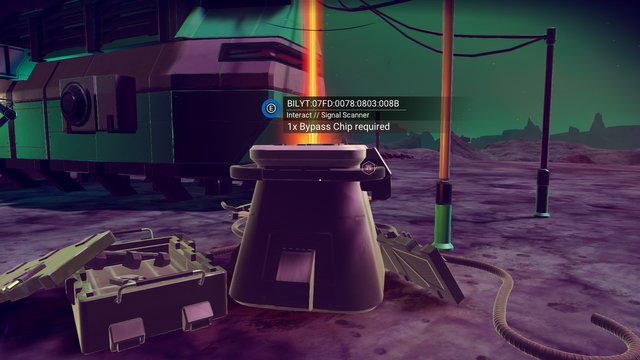
You can spot these from the sky - their red-orange beam shoots skywards. Land at the first of these you see. As soon as you land, make sure to Save at the checkpoint. This will gray it out, helping prevent you from revisiting locations. Your compass will also stay less cluttered. This becomes more important the longer you are on a planet.
2. Create Bypass Chips and search for 'Transmission'.
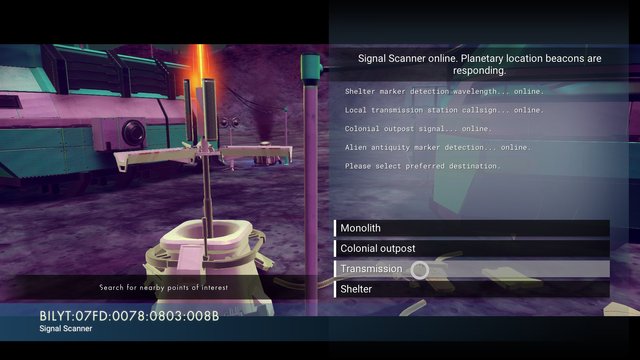
Repeat until a Transmission Tower is found. Ignore Observatories and Beacons. Each Bypass Chip will require crafting. For efficiency, I like to craft 2-4 at a time when I have space. You can also utilize the time the game is panning back down to earth to craft a new chip.
3. Fly to the Transmission Tower.
Note: As of Patch 1.09, the name will remain 'Transmission Tower', rather than amiguously reverting to 'Shelter' along with Observatories.
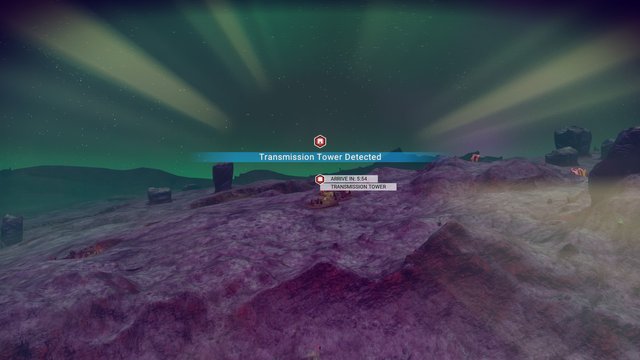
Here's an example of what a Transmission Tower looks like up close:
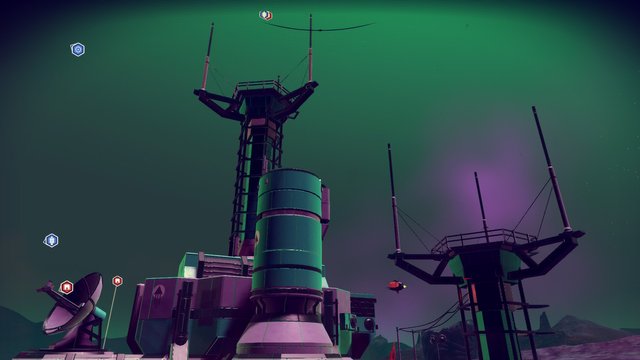
They all point to the sky, and unlike observatories, they tend to have pointed features and not rounded dishlike features.
Once you get inside, you'll find a (same-named) Transmission Tower item to interact with. It will ask you to solve a mathematical, pattern-based puzzle:
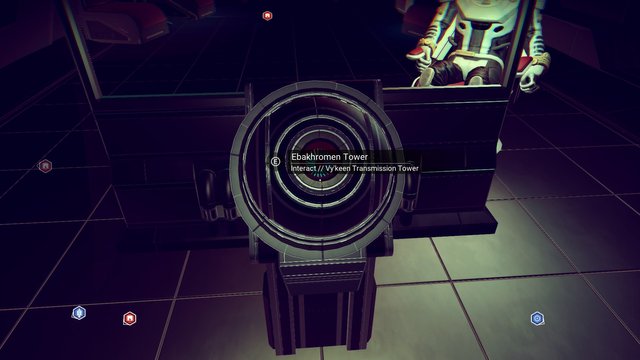
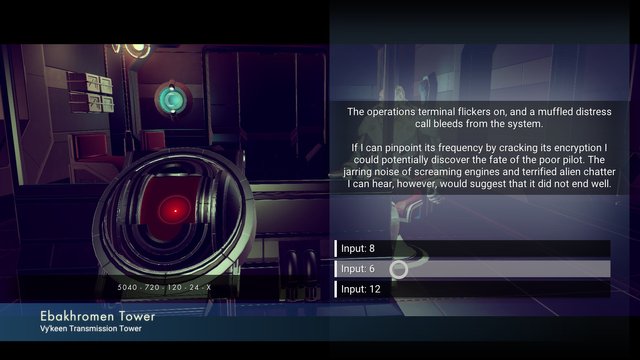
4. Fly to the newly identified Crashed Ship.
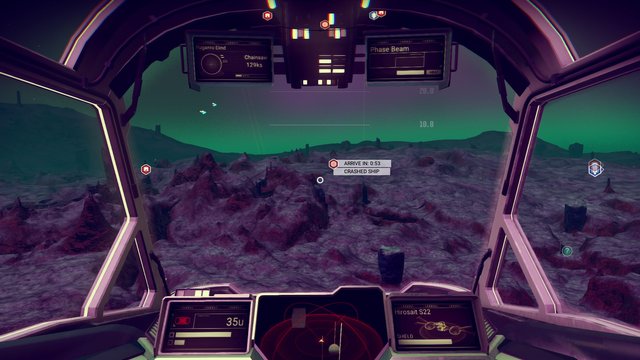
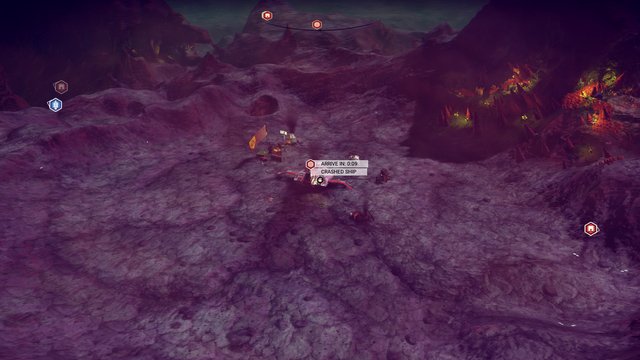
5. Compare sizes. If it is larger, dismantle, transfer, and Accept.
In the special case of being already maxed out, we are seeing a same-sized 48 slot ship.
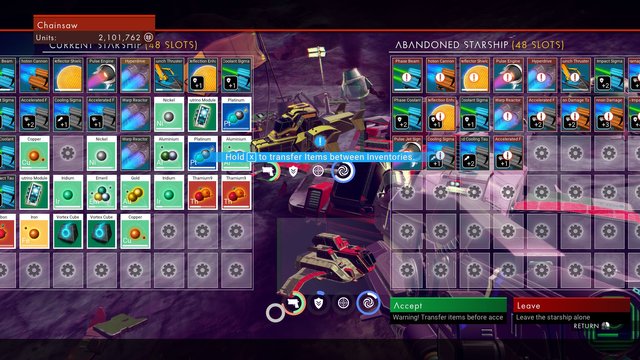
Transfer all your items, then Accept. If everything will not fit, abandon Microdensity Fabrics first, Carite Sheets next. Then discard anything that is replaceable instant mining (Iron, Carbon), or a space station visit.
Minimal Repair
Most ships will need both their Launch Thruster and their Pulse Engine repaired. Some will have one or both already functional. You will always need to add fuel in the form of Plutonium. Additionally prepare to craft 2, 4, or 6 Carite Sheets from Iron. Finally you'll need a bit of Heridium to repair the Pulse Engine.
Dismantle any technology which is not required.
Preparatory Steps Before Beginning the Search
Let's zoom out a bit. We've now gone through the nitty gritty of finding crashed ships. There are some steps we need to do in order to get set up and make the most of our hunting time.
Before we land on our first planet, we'll do some scouting. I like to tip the odds in my favor by finding an ideal solar system before beginning. I Prefer E (the green ones), and B/O (the blue ones) - they tend to be more hospitable. We go into this in more detail in the next section.
Next, we need to create space. We'll be holding onto our precious resources so we can add them back on at the end of our ship upgrading quest. For the remainder of this journey, we do not need ship tech, short of our engine and thrusters. Dismantle everything. Store small-stack items in your exosuit. Reserve ship space for high-demand items for ship hunting, such as Plutonium and Iron. Sell warp-related resources. Sell anything replaceable at a space station.
Finally, we need to stock up for ship hunting. Stay well stocked on Carbon, Iron, Plutonium, and Heridium. Get more than you need. You don't want to stop to have to refill resources any more than necessary. You will be making a lot of Bypass Chips. You'll be exploring, and refilling ships with an awful lot of Plutonium. Repairing the Pulse Engine and Launch Thrusters will require Carite Sheets, which take Iron. The Engine repair requires Heridium.
Now we've got an ideal system, inventory space, and the raw materials we need. With this, we'll simply execute the ship-finding steps until we've reached our starship size goal.
The first iteration will be the hardest. Your inventory will be fuller than it was in the beginning. Each subsequent ship, this squeeze will lighten, as you gain one new slot per upgrade. Remember to dismantle all non-vital gear for space on your new ship.
I liked to upgrade my ship 12 at a time, i.e. from 24 to 36, then much later from 36 to 48. When you are done, now you need to re-add your technology just one single time. There is a right and wrong way to do this, and the subject deserves an article all its own. Greatly oversimplifying, make sure you group your tech upgrades to the component they are upgrading for bonuses.
Selecting Good Planets for Hunting - Overhead and Efficiency Considerations
When it comes to ship hunting, all planets are not created equal. Two main criterion come to mind here - overhead and efficiency.
By overhead, I really mean - how much of your time on the planet are you able to dedicate to finding new ships? On an environmentally friendly planet, this is 100% minus Carbon/Iron/Plutonium regathering time. On an extreme planet or hostile planet, you may be spending up to 50% of your time on overhead.
By efficiency, I mean - how much of your time is spent searching, versus moving towards known targets? Most planets have an average density of sites to visit. Some are extremely dense, and some are extremely sparse. Make sure not to go ship hunting on a sparse planet.
Planning Out Your Solar System's Journey
When I commit to ship hunting, I like to choose a nice system (E/B/O), ideally with 6 celestial bodies. I take a look at all the planets, and while I am still in a safe ship, I travel to the 'endpoint' of my 6-planet journey. I choose the endpoint so that all future interplanetary travels will be the shortest distance possible. I then land on a planet and quickly rule it in or out based on the criteria above. For each planet that makes the grade, I remain their until I find myself re-discovering already discovered Transmission Towers, or becoming inundated by the two signals that do not need visiting - Observatories or Beacons.
Completing the Ship Upgrade Adventure
Once you finally have your ideal ship, you are going to need to upgrade its Warp Drive. Most efficiently, buy one from a Space Station. Most safely, retain one or craft one on-planet. Or, fly around until you find a trading station with access to a Trading Terminal.
Remember - you will never be more vulnerable in your ship than the first instant after you have upgraded it. Some people do not care about how much they die. Others do. If this is important to you, consider upgrading at least one ship weapon to perform adequately in combat, and also to apply a few shield upgrades before planning to venture far in space. You will be holding a lot of valuable cargo, so it is incredibly likely you will be attacked and unable to defend yourself if you leave the atmosphere without some basic protection. Speaking from experience, it puts a sour note on an otherwise victorious upgrade to emerge from a planet with a new ship, only to die seconds later.
One final tip - once you become visually comfortable enough, you can shortcut the Transmission Tower discovery by simply flying around a planet and spotting them from the air.
Did you enjoy this article? Is anything missing? Wish I'd cover something else? Let me know below! And do make sure to follow me so you won't miss future No Man's Sky articles.
Good guide for confused beginners to no mans Sky nice job!
Thank you, simonjay.